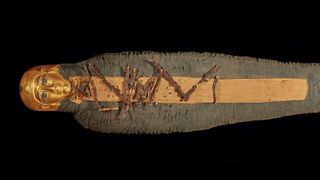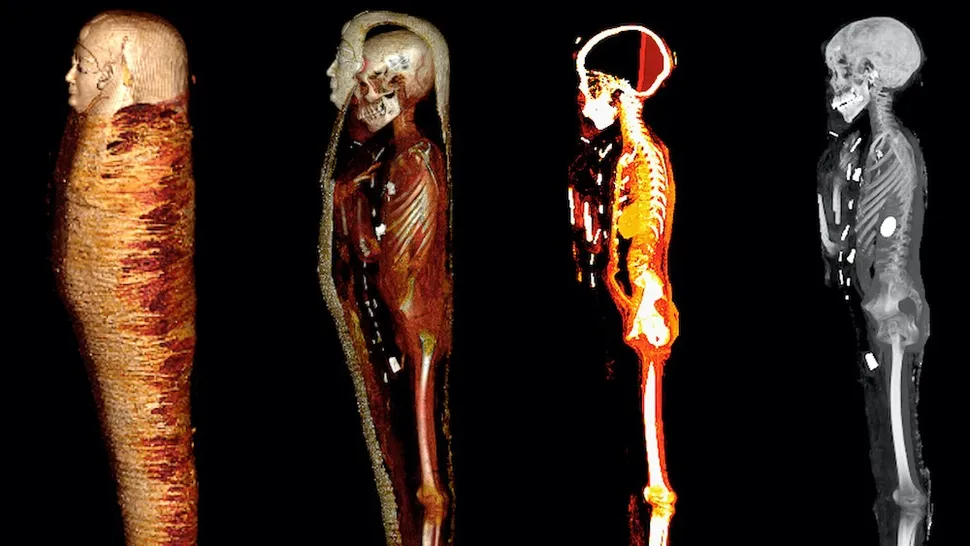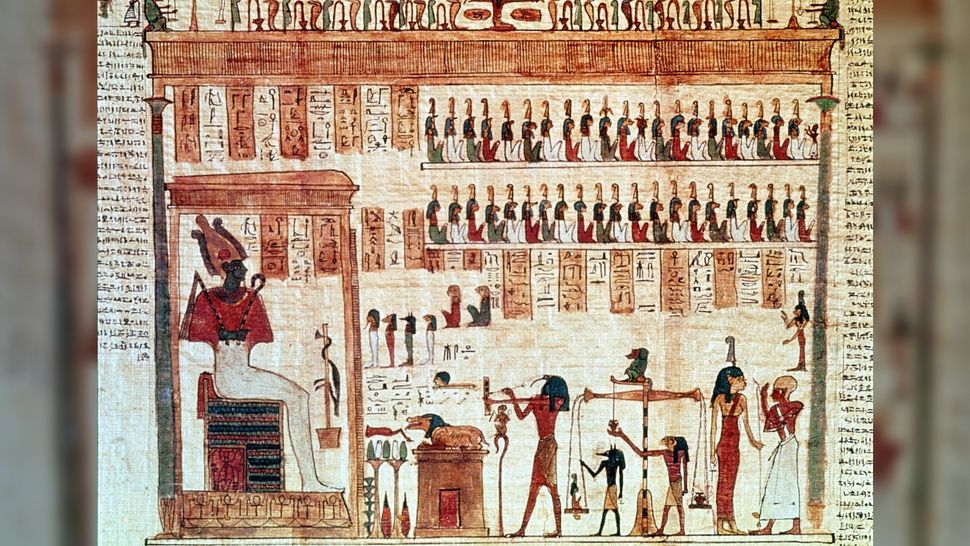Golden Boy and Ancient's Gold Amulets and Spells
By | January 2023

Incredibly detailed computed tomography (CT scans) of the so-called "Golden Boy" mummy from ancient Egypt have revealed a hidden trove of 49 amulets, many made of gold.
The young mummy earned its nickname because of the dazzling display of wealth, which included a gilded head mask (gold) found in the mummy's sarcophagus. Researchers think he was about 14 or 15 years old when he died because his wisdom teeth had not yet emerged.
The Golden Boy was originally unearthed in 1916 at a cemetery in southern Egypt and has been stored in the basement of The Egyptian Museum in Cairo ever since. The mummy had been "laid inside two coffins, an outer coffin with a Greek inscription and an inner wooden sarcophagus," according to a statement (opens in new tab).
While analyzing the scans, the researchers found that the dozens of amulets, comprised of 21 different shapes and sizes, were strategically placed on or inside his body.
Those included "a two-finger amulet next to the [boy’s] uncircumcised penis, a golden heart scarab placed inside the thoracic cavity and a golden tongue inside the mouth," according to the statement.
The mummy was also wearing a pair of sandals, and a garland of ferns was draped across his body, according to the statement.
"This mummy is a showcase of Egyptian beliefs about death and the afterlife during the Ptolemaic period," Sahar Saleem (opens in new tab), the study's lead author and a professor of radiology at the Faculty of Medicine, Cairo University in Egypt, told Live Science in an email.
FYI:
Ancient Egypt in North Africa was one of the most powerful and influential civilizations in the region for over 3,000 years, from around 3100 B.C to 30 B.C. It left behind numerous monuments, documents and works of art that continue to be studied by scholars today.
However Egyptian civilization existed long before this period, and it has survived and flourished since. While the civilization's rulers, language, writing, climate, religion and borders have changed many times over the millennia, Egypt still exists as a modern-day country.
Ancient Egypt was closely connected with other parts of the world, bringing in and exporting goods, religions, food, people and ideas. At times ancient Egypt ruled territory outside the modern-day country's border, controlling territory in what is now Sudan, Cyprus, Lebanon, Syria, Israel and Palestine. The country was also occupied by other powers in ancient times — the Persians, Nubians, Greeks and Romans all conquered Egypt at different points. (Not exactly... )
While researchers aren't sure of the mummy's true identity, based on the grave goods alone, they think he was of high socioeconomic status. The amulets served important roles in the afterlife.
"Ancient Egyptians believed in the power of amulets … and they were used for protection and for providing specific benefits for the living and the dead," Saleem said. "In modern science, this is explained by energy. Different materials, shapes and colors (e.g. crystals) provide energy with different wavelengths that could have [an] effect on the body. Amulets were used by ancient Egyptians in their lives. Embalmers placed amulets during mummification to vitalize the dead body."
For example, the teenage mummy's tongue was capped in gold "to enable the deceased to speak" and the sandals "were to enable the deceased to walk out of the tomb in the [afterlife]," Saleem said.
However, one amulet in particular stood out to Saleem: the golden heart scarab placed inside the torso cavity. She wound up creating a replica of it using a 3D printer.
"It was really amazing especially after I 3D printed [it] and was able to hold it in my hands," Saleem said. "There were engraved marks on the back that could represent the inscriptions and spells the priests wrote to protect the boy during his journey. Scarabs symbolize rebirth in ancient Egyptians and [were] in the form of a discoid (disc-shaped) beetle."
She added that the heart scarab measured about 1.5 inches (4 centimeters) and was inscribed with verses from "The Book of the Dead," an important ancient Egyptian text that helped guide the deceased in the afterlife.
"It was very important in the afterlife during judging the deceased and weighing of the heart against the feather of Maat (the goddess of truth)," Saleem said. "The heart scarab silenced the heart [on] judgement day so not to bear witness against the deceased. A heart scarab was placed inside the torso cavity during mummification to substitute for the heart if the body was ever deprived [of] this important organ for any reason."
The findings were published Jan. 24 in the journal Frontiers of Medicine (opens in new tab).
Egyptians are the same people as the ANCIENT MINOANS/ROMANS to today
Related: Ancient Egyptian mummification was never intended to preserve bodies, new exhibit reveal
SPELLS?
Book of the Dead's spells
The "Book of the Dead" includes individual chapters, or spells. "The ancient Egyptians used the word rꜢ to designate each composition. The word rꜢ is generally translated as 'spell' or 'utterance.' It is written with the hieroglyph of a human mouth because the term was related to speech," Foy Scalf, the head of research archives at the University of Chicago who holds a doctorate in Egyptology, told Live Science in an email.
There wasn't a standard book found in every tomb. Instead, each copy contained different spells. "No one such 'book' contains all known spells, but only a judicious sampling," Dorman wrote, noting that "no single 'Book of the Dead' scroll is identical to another."
The ancient Egyptians called these texts the "Book of Coming Forth by Day," Dorman wrote, noting that this name reflected "the Egyptians' belief that the spells were provided to assist the deceased in entering the afterlife as a glorified spirit, or akh."
These texts "prepared the Egyptians for life after death and [had] the power to conjure up all the parts of one's body for the spiritual journey," wrote Barry Kemp, professor emeritus of Egyptology at the University of Cambridge, in his book "How to Read the Egyptian Book of the Dead (opens in new tab)" (W.W. Norton & Company, 2007). "The Book of the Dead, by means of its spells, conferred on the owner the power to navigate successfully — for eternity — through [the underworld's] various realms" Kemp wrote.
A section of the "Book of the Dead." Here we see judgment of the dead, with the weighing of the heart ritual. (Image credit: Photos.com via Getty Images)
Some spells appear more frequently in copies of the "Book of the Dead" than others, and some were considered almost essential. One of these essential spells is now known as Spell 17, which discusses the importance of the sun-god Re (also called Ra), one of the most important Egyptian gods, Dorman noted.
The ancient Egyptians believed that the body of the deceased could be renewed in the afterlife leaving a person to navigate a place of "gods, demons, mysterious locations and potential obstacles," wrote Kemp. The chapters of the "Book of the Dead" described some of the things one might encounter — such as the weighing of the heart ceremony in which a person's deeds were weighed against the feather of the goddess Maat, a deity associated with justice.
The spells were often illustrated. "Pictures [were] of great importance in the New Kingdom collection of funerary texts now called the Egyptian Book of the Dead," wrote Geraldine Pinch, an Egyptologist, in her book "Egyptian Myth: A Very Short Introduction (opens in new tab)" (Oxford University Press, 2004). "Many owners of Books of the Dead would have been unable to read the hieroglyphic texts, but they could understand the complex vignettes that summarized the contents of the spells" Pinch wrote.
The spells were not gender specific. It didn't have "spells that were used particularly by women" or spells that were used primarily by men, Marissa Stevens, an Egyptologist and assistant director of the Pourdavoud Center for the Study of the Iranian World at the University of California, Los Angeles, told Live Science in an email.
SOURCE: https://www.livescience.com/ancient-egypt-book-of-the-dead





Comments
Post a Comment
leave a message please